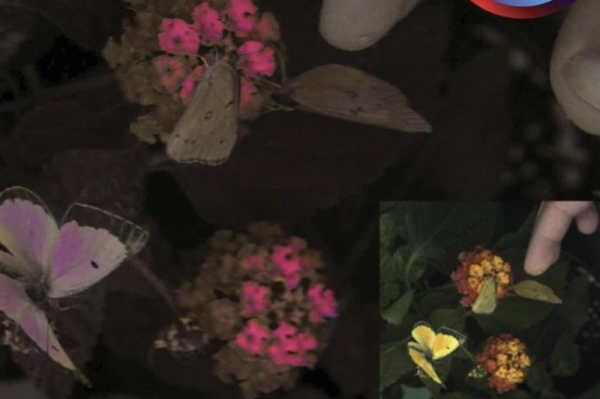New camera system captures how animals see colors in motion

A new video camera system is giving humans a glimpse into how animals see colors in motion, according to researchers at the Hanley Color Lab at George Mason University and at the University of Sussex. This image of three male orange sulphurs Colias eurytheme is an example of how humans and animals see things differently. Photo courtesy of Daniel Hanley, George Mason University
A new video camera system is giving humans a glimpse into how animals see colors in motion as they navigate nature, researchers say.
“Each animal has a unique set of photoreceptors, which means they perceive color differently,” according to scientists, at the Hanley Color Lab at George Mason University and at the University of Sussex, who developed the camera and software system that captures “animal-view videos.” The study was published Tuesday in the journal PLOS Biology. Advertisement
“We’ve long been fascinated by how animals see the world. Modern techniques in sensory ecology allow us to infer how static scenes might appear to an animal; however, animals often make crucial decisions on moving targets,” George Mason University senior author Daniel Hanley said, adding that those movements could be used to detect prey, danger or evaluate a potential mate’s display.
“Here, we introduce hardware and software tools for ecologists and filmmakers that can capture and display animal-perceived colors in motion,” Hanley added in a post on X, along with a video that shows what different animals see.
Camera recreates colour vision of different animals https://t.co/0qK8dzZ2gd via @YouTube— Daniel Hanley (@HanleyColorLab) January 23, 2024
Advertisement
According to Hanley, birds can see ultraviolet light, which dominates their view of the sky, and a honeybee’s view of a spider moving on a flower is far different than what a human sees.
“Animals like honeybees and some birds can see UV light, which are outside the range of human perception,” the study said.
Researchers used the new camera and software to replicate the photoreceptors in the eyes of various animals to see how they perceive the world differently. Replicating the colors can also help scientists better understand how different animals navigate their environments.
The camera captures videos from an animal’s view of moving objects under natural lighting conditions. The camera records the video in four color channels of blue, green, red and UV. In contrast, the human eye contains three photoreceptors that capture blue, green and red light.
“The team tested the system against a traditional method that uses spectrophotometry and found that the new system predicted perceived colors with an accuracy of over 92%,” researchers said.
“This novel camera system will open new avenues of research for scientists, and allow filmmakers to produce dynamic, accurate depictions of how animals see the world around them.”
